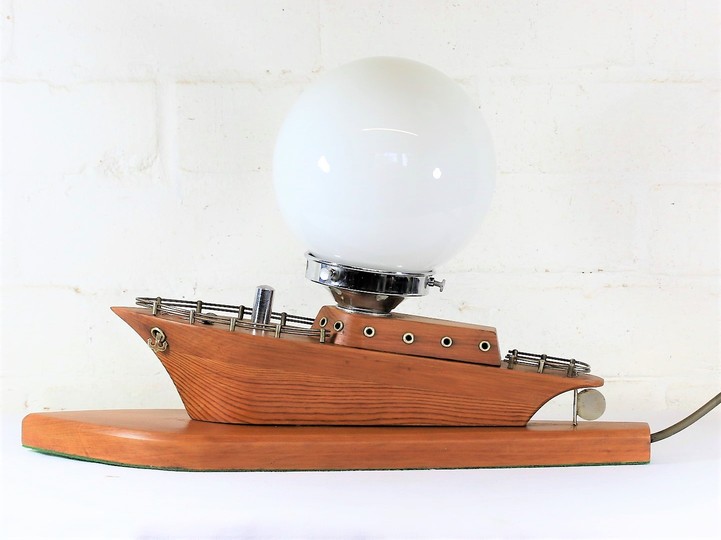An old shipwreck waiting for a new life.
The Art Deco period sparked a huge interest in modernist “new” and exciting designs. Angles, exaggerated curves and geometric patterns were used to catch the eye of a public that was thirsty for this new and exciting age of modernist lifestyle and travel. The influence of the new Art Deco movement made its way into everyday life with the design ethos finding its way into advertising, artwork and architecture. This interest made its way into many homes in decorative pieces, home wares and of course lighting.
A fairly common example of this Art Deco influence is a classic nautical table lamp with a stylised wooden sailing boat set with sweeping sails and having a distinctly Art Deco influence in its design and shape.
These lamps were produced in large quantities up to the 1950s and usually had sail-shaped lampshades made of dried hide or animal skin. Not many of these lamps survived in the original condition as the shades tended to go brittle and would crack due to the heat from old incandescent light bulbs.
Many of the old wooden bases were disposed of over the years especially as the Art Deco influence gradually lost mass popularity and eventually went out of style.
At a recent flea market, I found a large and really nice example of one of these original vintage Art Deco table lamps.
I was instantly drawn to the lamp by its highly stylised and curved shape and the fact that it was still mounted on its lovely oversize wooden base, the lamp also had all of its original decorative nautical fittings, this fabulous old shipwreck of a lamp was a restoration project in waiting.

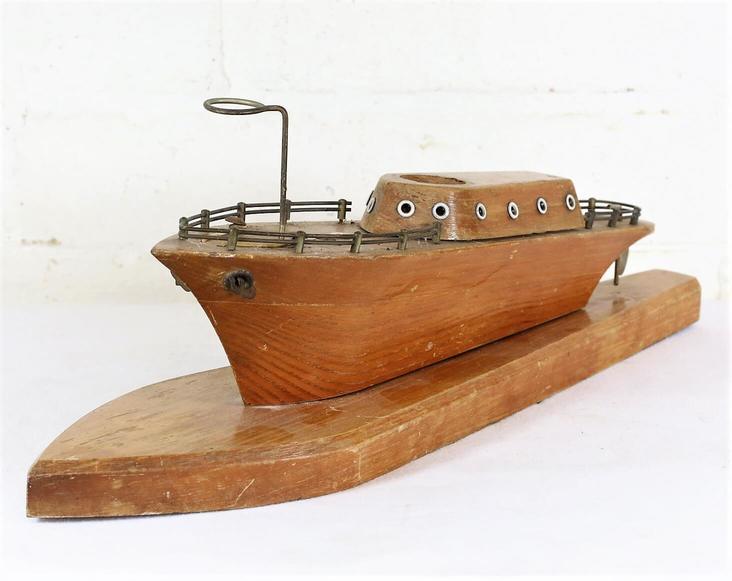
The Vintage Art Deco nautical table lamp as found.
This lamp would have originally had two hide sail lampshades, the surface of the wood was covered with its original thick and very tough varnish which had protected the wood well but was well past decent cosmetic use. The lamp has a hole in the top where one of the bulb holders would have been mounted and is complete with bumps, marks and scars from age and use. My plan was to find a way to mount a glass globe lampshade onto the base and to bring it back to life as an Art Deco nautical table lamp for the 21st century. The first task to carry out is to disassemble the lamp into its component parts.

The lamp in pieces.
As you can see from the images above the original varnished finish was well past its best so the next step was to remove this. I always use a strong paint stripper in a very well ventilated room (preferably outside). Paint strippers available in high streets tend to be quite weak so I use professional grade stripper that I buy online and it works really well. The paint stripper was applied and left for a few minutes before being gently scraped off the surface of the lamp, luckily despite its impressive thickness the varnish came away quite easily. Some of the original metal fittings on the lamp were plastic coated, these were also stripped back to reveal brass and copper materials under.
Once the varnish was removed the beauty of the wood started to show and an amazing hidden feature was revealed; The ships body was in fact made in sections that were joined, whoever made the original lamp had chosen a piece of highly grained wood for the hull and had positioned the grain to imitate water washing along the hull, little details like these make you realise that years ago everyday items were made with a fine eye for design and the final product appearance.
Once the paint stripper was removed the lamp was cleaned using nourishing oils and the wood used in the construction of the lamp started to come to life.
The stripped and cleaned wooden parts of the lamp.
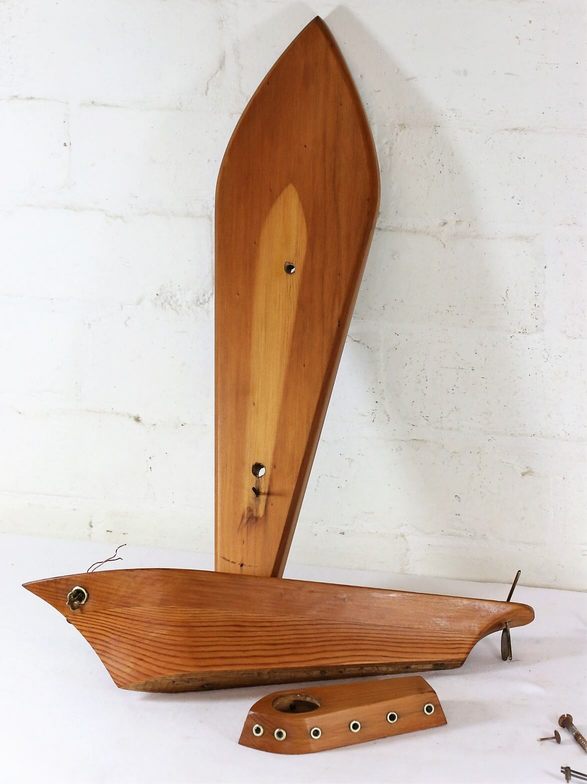
As I examined the lovely wood grain and the way that it had been made with such care I realised that a globe lampshade was the way to go, the use of a glass globe would not only allow the wood to shine but would also highlight the great nautical profile of the lamp when lit. I had in stock a perfect and original period white cased glass globe lampshade which I matched with a new modern chrome 3 screw gallery and a number of sundries and bits and pieces that would allow me to re-float this lovely old lamp. I also found a very old chromed Art Deco finial which was perfect to plug a hole on deck.

Components ready for assembly.
Rewiring was the next step. The lamp base needed a few adjustments as the wiring path for the old original thin 2 core wiring was small and tight, the wiring path was opened up carefully using wood drills and files. During reassembly of the lamp, an earth point was fitted under the period brass bulb holder. The lamp reassembly was completed with the new chromed gallery sitting atop the lamp base in the same position as one of the original bulb holders.
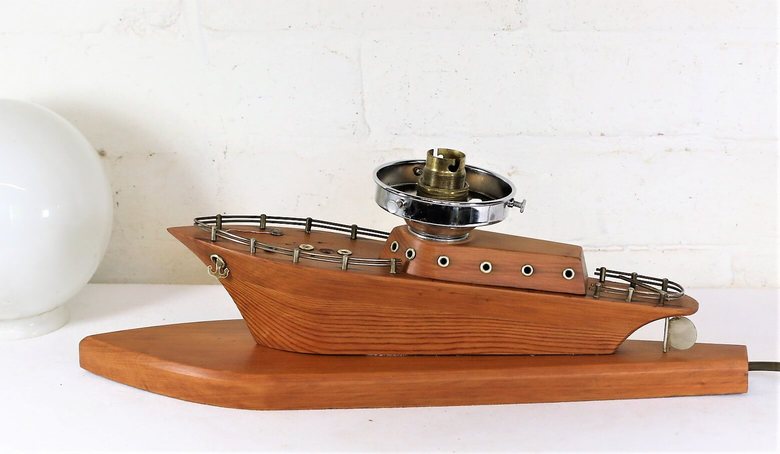
The lamp reassembled and ready for refinishing.
The last stages of this type of restoration are always the most satisfying. The wooden lamp base was refinished with three coats of a quality dark wax which really brought out the grain of the wood, the wiring was fitted with an in-line switch.
The cleaned glass globe was fitted and underneath the lamp was given a new green felt base to match the original.


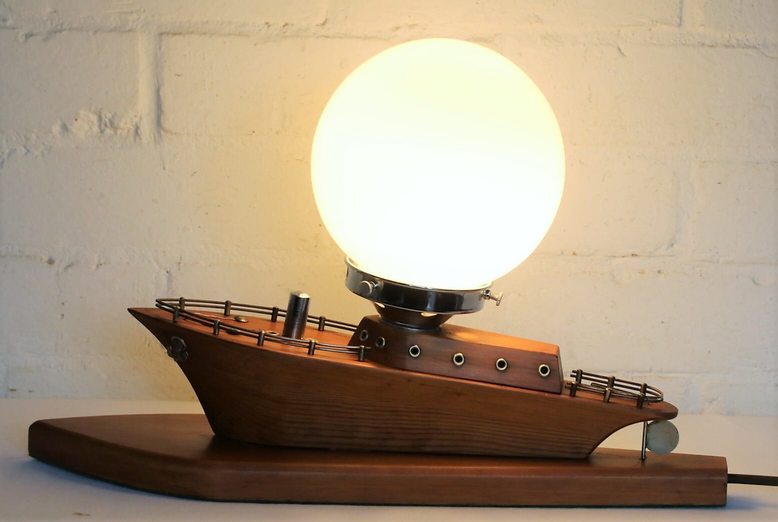
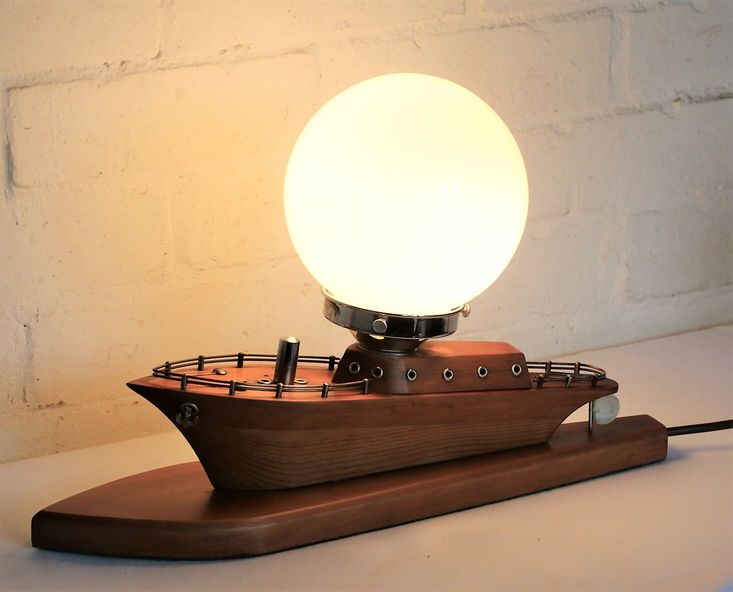
When alight and in use, the small details of the lamp and the excellent graining of the wood really shine. It brings me great pleasure to breath new life into such a great looking old lamp. It would now make a great desk lamp or hallway welcome lamp in a seaside home. I hope that you have enjoyed reading my post and that this may encourage you to “go green” and give life to a Vintage or Antique item.
Time Spent on the lamp – 3.5 Hours.
I often have a number of Vintage Industrial items for sale in my eBay shop here – Hertfordshire Lighting and Design
I would love to hear from anyone who has performed a similar refinishing/salvaged project; it’s always great to share ideas with other people.
If you have any questions or need advice on any item of Vintage lighting please contact me and I will do my best to help.
Michael Adkins. michael@hertfordshire-lighting.com
